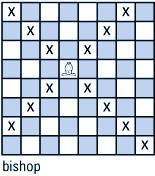
Chess is a game of strategy, where each piece plays a crucial role in determining the outcome of the game. Among the powerful pieces on the board, the bishop stands out with its unique movement patterns and strategic capabilities. In this beginner’s guide, we’ll delve into the world of bishops, exploring their movements, the concept of the bishop pair, and strategies for utilizing bishops to control key diagonals, all explained below.
Understanding The Bishop’s Dance: A Diagonal Journey
Imagine the bishop as a swift and diagonal dancer on the chessboard. Unlike other pieces restricted to straight-line movements, the bishop glides effortlessly diagonally across squares, covering both light and dark ones. Its unique mobility allows it to influence a significant portion of the board, making it a dynamic force.
The Power of the Bishop Pair
The term “bishop pair” refers to a situation where a player controls both bishops. Having the bishop pair is considered advantageous because it provides versatility in controlling squares of both colors. Picture it like having two dancers gracefully twirling across different diagonals, complementing each other’s movements.
Diagonal Control: The Bishop’s Domain
Bishops excel in controlling diagonals, which are the diagonal lines formed by squares of the same color. By strategically placing bishops on key diagonals, you can exert influence over critical areas of the board. This control can limit your opponent’s options and set the stage for tactical maneuvers.
The Bishop’s Limitation: Color-bound Movement
While the bishop’s diagonal movement is a strength, it also comes with a limitation – each bishop is confined to squares of only one color throughout the game. This color-bound nature requires thoughtful positioning to ensure that both bishops cover a broad spectrum of the board.
Utilizing Bishops in the Opening
In the opening phase of the game, deploying bishops strategically is crucial. Placing bishops on squares that control the center or target key diagonals can set the tone for your position. Avoid trapping your bishops behind your pawn structure, as it limits their early-game influence.
Maneuvering Bishops in Closed Positions
In closed positions where pawns and pieces block the board, bishops require careful maneuvering to maximize their effectiveness. Look for opportunities to reposition bishops to more favorable diagonals or exchange them for opponent’s knights, which may be restricted by pawn structures.
The Art of Bishop Development
Bishop development involves finding optimal squares for your bishops to contribute actively to the game. Early in the game, consider developing bishops to squares like c4/c5 or f4/f5, aiming to control important diagonals and influence the center.
Bishop Exchanges and Imbalances
Exchanging bishops with your opponent can create imbalances in the position. If you can trade a less valuable opponent’s bishop for your more strategically placed one, it might lead to a positional advantage. Evaluate such exchanges based on the position and the overall strategy.
Bishop Sacrifices: A Tactical Weapon
Sometimes, sacrificing a bishop can lead to significant tactical advantages. By sacrificing a bishop, you can open lines, expose weaknesses in the opponent’s position, or create mating threats. Bishop sacrifices require careful calculation and foresight but can be a powerful tool in the hands of a skilled player.
Bishop Endgames: The Road to Victory
As the game progresses into the endgame, bishops retain their power. Their long-range diagonal movements become more pronounced, and a well-placed bishop can dominate the board. Be mindful of pawn structures, as bishops can play a crucial role in supporting pawn advances.
The Double-Edged Nature of Bishops
While bishops are potent pieces, their effectiveness depends on the position and pawn structure. Open positions with long diagonals favor bishops, while closed positions might limit their mobility. Understanding when to unleash the full potential of your bishops is key to mastering their strategic value.
The Bishop’s Influence on Pawn Structures
Bishops can significantly impact pawn structures. Consider the pawn structure before making bishop moves, as their influence can shape the game. Bishops are particularly effective in positions with pawn chains or pawn islands, where they can target weaknesses.
Bishop Tactics: Pins and Skewers
Bishops are adept at executing tactical maneuvers, such as pins and skewers. A pin involves immobilizing an opponent’s piece to a more valuable one behind it. Skewers target two pieces in a line, forcing the opponent to lose one of them. Incorporating these tactics enhances the strategic impact of bishops.
Common Mistakes with Bishops
Avoid common pitfalls when handling bishops. One mistake is neglecting their development, leaving them inactive. Additionally, be cautious of creating weaknesses in your pawn structure by moving pawns in front of your bishops without careful consideration.
Developing a Bishop-Centric Strategy
To develop a bishop-centric strategy, focus on maximizing the potential of your bishops throughout the game. Coordinate them to control key diagonals, prioritize central influence, and aim for a strong pawn structure that complements the bishop pair.
In Summary : Embracing the Bishop’s Power
Bishops are dynamic pieces with a unique ability to control diagonals and shape the chessboard. Understanding their movements, aiming for the bishop pair, and strategically placing them on key squares can elevate your chess game. Picture your bishops as nimble dancers, gracefully influencing the game with every diagonal move. As you progress on your chess journey, continue honing your understanding of bishops, experiment with different strategies, and let the dance of the bishops guide you to victory on the chessboard.


One thought on “Unleashing the Bishop: A Beginner’s Guide to Mastering Chess”
Comments are closed.